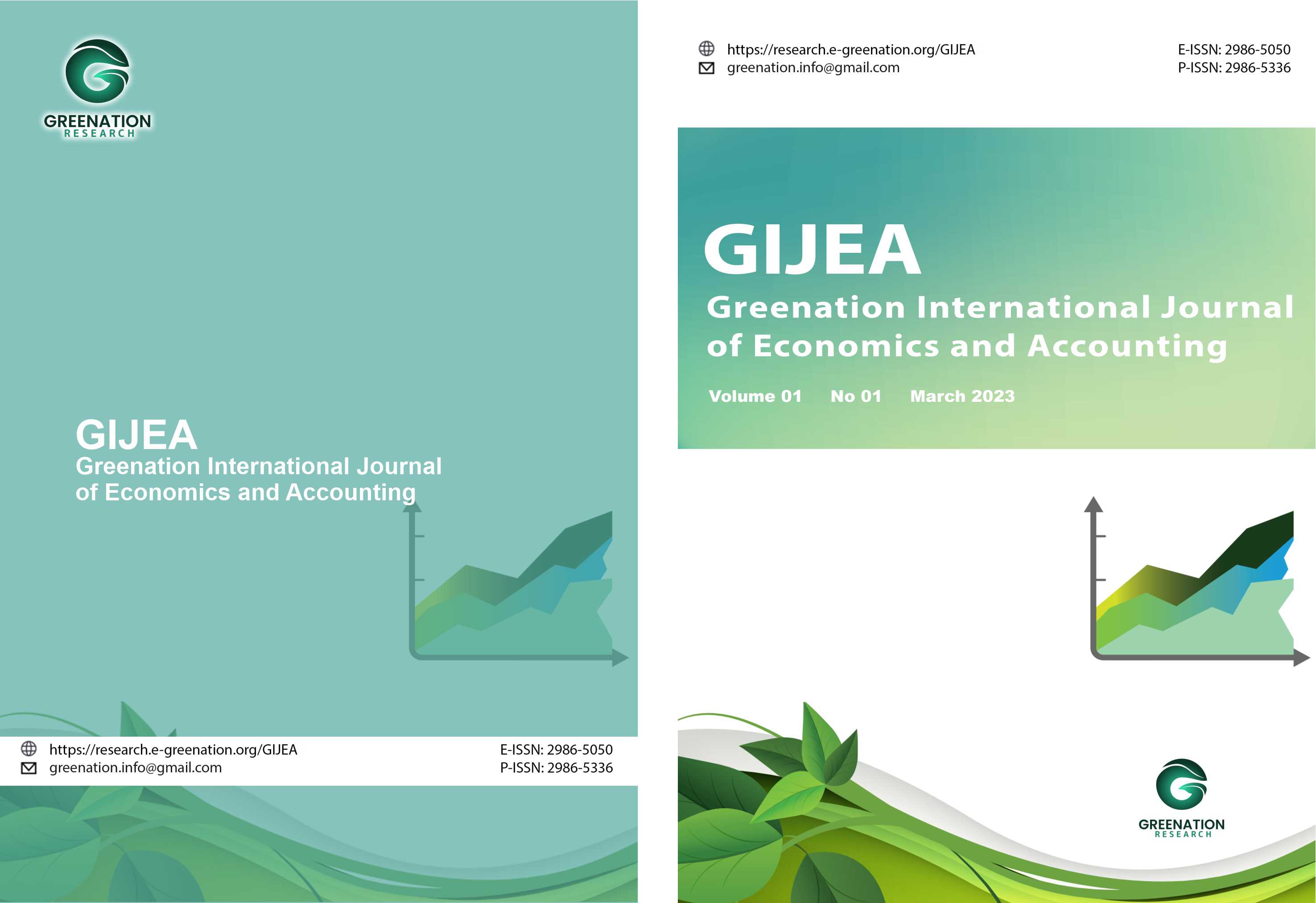The Effect of Financial Performance on Stock Returns of Non- Banking Companies in Indonesia
DOI:
https://doi.org/10.38035/gijea.v2i2.215Keywords:
Financial Performance, Return on Assets, Return on Equity, Current Ratio, Debt to Equity Ratio, Economic Value Added, Stock ReturnsAbstract
This study objectively examines how financial performance metrics affect stock returns. ROA, ROE, CR, DER, and EVA are being examined. This study uses secondary data from external sources. This study used purposive sampling to choose a sample based on criteria. This study covers 2015–2023 Indonesia Stock Exchange (IDX) LQ 45 Index non- banking companies. Companies from the LQ 45 Index and Sri Kehati Index were carefully selected for the sample. The sample included 46 non-banking firms. As the best analysis model, panel data regression with fixed effect was used. Insignificant association exists between ROA and stock returns.
References
Ahmed, H., & Elsayed, A. H. (2019). Are Islamic and conventional capital markets decoupled? Evidence from stock and bonds/sukuk markets in Malaysia. Quarterly Review of Economics and Finance, 74, 56–66. https://doi.org/10.1016/j.qref.2018.04.005
Al-Khazali, O. (2014). Revisiting fast profit investor sentiment and stock returns during Ramadan. International Review of Financial Analysis, 33, 158–170. https://doi.org/https://doi.org/10.1016/j.irfa.2014.02.003
Alam, N., Binti Zainuddin, S. S., & Rizvi, S. A. R. (2019). Ramifications of varying banking regulations on performance of Islamic Banks. Borsa Istanbul Review, 19(1), 49–64. https://doi.org/https://doi.org/10.1016/j.bir.2018.05.005
Antônio, R. M., Lima, F. G., & Junior, T. P. (2015). Stock recommendations and investment portfolio formation: A study in the Brazilian market. Contaduría y Administración, 60(4), 874–892. https://doi.org/https://doi.org/10.1016/j.cya.2015.07.010
Anwaar, M. (2016). Impact of Firms’ Performance on Stock Returns (Evidence from Listed Companies of FTSE-100 Index London, UK). Global Journal of Management and Business Research, 16(1), 678–685. https://globaljournals.org/GJMBR_Volume16/4- Impact-of-Firms-Performance.pdf
Arnova, I. (2016). Pengaruh Ukuran Kinerja Roa, Roe, Eps Dan Eva Terhadap Return Saham. EKOMBIS REVIEW: Jurnal Ilmiah Ekonomi Dan Bisnis, 4(1), 36–53. https://doi.org/10.37676/ekombis.v4i1.153
Awan, A. G., Siddique, K., & Sarwar, G. (2014). The Effect Of Economic Value Added On Stock Return?: Evidence From Selected Companies Of Karachi Stock Exchange . Research Journal of Finance and Accounting, 5(23), 140–152.
Berkowitz, D., Hoekstra, M., & Schoors, K. (2014). Bank privatization, finance, and growth. Journal of Development Economics, 110, 93–106. https://doi.org/https://doi.org/10.1016/j.jdeveco.2014.05.005
Chandra, K. (2019). Return on Equity Effect and Debt To Equity Ratio on Return Stock of Food and Beverage. Business and Entrepreneurial Review, 16(1), 31–44. https://doi.org/10.25105/ber.v16i1.4908
Chinedu, I., Agu, C., & Nnagbogu, E. (2014). The Effect of Financial Leverage on Financial Performance: Evidence of Quoted Pharmaceutical Companies in Nigeria. IOSR Journal of Economics and Finance, 5, 17–25. https://doi.org/10.9790/5933-0531725
Chouikh, A., & Blagui, Y. (2017). The Determinants of Bank Performance: The Case of Tunisian Listed Banks. Journal of Finance and Accounting, 5(2), 53–60. https://doi.org/10.12691/jfa-5-2-4
Cieslak, A., & Schrimpf, A. (2019). Non-monetary news in central bank communication. Journal of International Economics, 118, 293–315. https://doi.org/https://doi.org/10.1016/j.jinteco.2019.01.012
Cipollini, A., & Fiordelisi, F. (2012). Economic value, competition and financial distress in the European banking system. Journal of Banking & Finance, 36(11), 3101–3109. https://doi.org/https://doi.org/10.1016/j.jbankfin.2012.07.014
Co?kun, Y., Seven, Ü., Ertu?rul, H. M., & Ulussever, T. (2017). Capital market and economic growth nexus: Evidence from Turkey. Central Bank Review, 17(1), 19–29. https://doi.org/https://doi.org/10.1016/j.cbrev.2017.02.003
Farizal Mohammed, N., Ahmad Puat, S., Susanti Amirrudin, M., & Hashim, A. (2020). Leverage, Liquidity and Profitability Ratios: Accountability of Malaysian Listed Oil and Gas Firms. Humanities & Social Sciences Reviews, 8(2), 941–947. https://doi.org/10.18510/hssr.2020.82104
Ferris, S. P., Hanousek, J., Shamshur, A., & Tresl, J. (2018). Asymmetries in the Firm’s use of debt to changing market values. Journal of Corporate Finance, 48, 542–555. https://doi.org/https://doi.org/10.1016/j.jcorpfin.2017.12.006
Gupta, R. (2017). Economic Value Added: theory and implications. Inspira-Journal of Commerce, Economics & Computer Science (JCECS), 03(03), 345–350.
Hadi, N. (2013). Pasar Modal Acuan Teoritis dan Praktis Investasi di Instrumen Keuangan Pasar Modal (Pertama). Graha Ilmu.
Hery. (2015). Analisis Laporan Keuangan. CAPS (Center for Academic Publishing Service). Hunt-Ahmed, K. (2013). Contemporary Islamic Finance: Innovations, Applications, and Best
Practices. John Wiley & Sons, Inc.
Irman, M., Purwati, A. A., & Juliyanti. (2020). Analysis On The Influence Of Current Ratio, Debt to Equity Ratio and Total Asset Turnover Toward Return On Assets On The Otomotive and Component Company That Has Been Registered In Indonesia Stock Exchange Within 2011-2017. International Journal of Economics Development Research (IJEDR), 1(1), 36–44. https://doi.org/10.37385/ijedr.v1i1.26
Jakub, S., Viera, B., & Eva, K. (2015). Economic Value Added as a Measurement Tool of Financial Performance. Procedia Economics and Finance, 26, 484–489. https://doi.org/https://doi.org/10.1016/S2212-5671(15)00877-1
Khidmat, W. Bin, & Rehman, M. U. (2014). Impact of Liquidity & Solvency on Profitability Chemical Sector of Pakistan. Ekonomika Management Inovace, 6(3), 1805–353. http://emi.mvso.cz
Law, C., Cornelsen, L., Adams, J., Penney, T., Rutter, H., White, M., & Smith, R. (2020). An analysis of the stock market reaction to the announcements of the UK Soft Drinks Industry Levy. Economics & Human Biology, 38, 100834.
https://doi.org/https://doi.org/10.1016/j.ehb.2019.100834
McGurk, Z., Nowak, A., & Hall, J. C. (2020). Stock Returns and Investor Sentiment: Textual Analysis and Social Media. Journal of Economics and Finance, 44(3), 458–485. https://doi.org/10.1007/s12197-019-09494-4
Nurhikmawaty, D., I., & Widiyanti, M. (2020). The Effect of Debt to Equity Ratio and Return on Equity on Stock Return with Dividend Policy as Intervening Variables in Subsectors Property and Real Estate on Bei. Open Journal of Business and Management, 08(05), 2148–2161. https://doi.org/10.4236/ojbm.2020.85131
Olson, D., & Zoubi, T. (2017). Convergence in bank performance for commercial and Islamic banks during and after the Global Financial Crisis. The Quarterly Review of Economics and Finance, 65, 71–87. https://doi.org/https://doi.org/10.1016/j.qref.2016.06.013
Raharjo, D., & Muid, D. (2013). Analisis Pengaruh Faktor-Faktor Fundamental Rasio Keuangan Terhadap Perubahan Harga Saham. Diponegoro Journal of Accounting, 2(2), 1–11. http://ejournal-s1.undip.ac.id/index.php/accounting
Santosa, P. W. (2019). Financial Performance, Exchange Rate and Stock Return: Evidence from Manufacturing Sector. Jurnal Manajemen Teknologi, 18(3), 205–217.
https://doi.org/10.12695/jmt.2019.18.3.5
Siahaan, S. M. N., Sadalia, I., & Silalahi, A. S. (2021). Effect of Financial Ratios on Stock Returns with Earning Per Share as Moderating Variable in Banking Companies on the Indonesia Stock Exchange (2012-2017 Period). International Journal of Research and Review, 8(8), 398–406. https://doi.org/10.52403/ijrr.20210855
Sunaryo, D. (2021). The Effect of Current Ratio (CR), Debt to Equity Ratio (DER), and Earning Per Share (EPS) on Share Prices With Returning Assets as a Moderated Variables in Food and Beverage Companies Subsector Companies19 In 2012-2019 Asia Stock Exchange. Management, Business and Social Science (IJEMBIS), 1(1), 98–110. https://cvodis.com/ijembis/index.php/ijembis
Supriantikasari, N., & Utami, E. S. (2019). PENGARUH RETURN ON ASSETS, DEBT TO EQUITY RATIO, CURRENT RATIO, EARNING PER SHARE DAN NILAI TUKAR
TERHADAP RETURN SAHAM (Studi Kasus Pada Perusahaan Go Public Sektor Barang Konsumsi Yang Listing Di Bursa Efek Indonesia Periode 2015-2017). Jurnal Riset Akuntansi Mercu Buana, 5(1), 49. https://doi.org/10.26486/jramb.v5i1.814
Tan, Z., Yan, Z., & Zhu, G. (2019). Stock selection with random forest: An exploitation of excess return in the Chinese stock market. Heliyon, 5(8), e02310. https://doi.org/https://doi.org/10.1016/j.heliyon.2019.e02310
Thampanya, N., Wu, J., Nasir, M. A., & Liu, J. (2020). Fundamental and behavioural determinants of stock return volatility in ASEAN-5 countries. Journal of International Financial Markets, Institutions and Money, 65, 101193.
https://doi.org/https://doi.org/10.1016/j.intfin.2020.101193
Tumonggor, M., Murni, S., & Rate, P. V. (2017). HE EFFECT OF CURRENT RATIO, RETURN ON EQUITY, DEBT TO EQUITY RATIO AND GROWTH ON STOCK RETURN OF COSMETICS AND HOUSEHOLD INDUSTRY LISTED IN BEI PERIOD 2010-2016. Jurnal EMBA, 5(2), 2203–2210.
Udiyana, I. B. G., Astini, N. N. S., Parta, I. N., Laswitarni, N. K., & Wahyuni, L. A. (2022). Economic Value Added (EVA) and Market Value Added (MVA) Implications on Stock Returns. Jurnal Ekonomi & Bisnis JAGADITHA, 9(1), 15–22. https://doi.org/10.22225/jj.9.1.2022.15-22
Wayan, J. I., & Anom, P. I. B. (2020). the Effect of Financial Performance on Stock Return At Manufacturing Company of Indonesia Stock Exchange. Russian Journal of Agricultural and Socio-Economic Sciences, 97(1), 11–19. https://doi.org/10.18551/rjoas.2020-01.02
Downloads
Published
How to Cite
Issue
Section
License
Copyright (c) 2024 Andre Suryaningprang, Yoyo Sudaryo, Andhika Mochamad Siddiq, Dedi Supiyadi

This work is licensed under a Creative Commons Attribution 4.0 International License.
Copyright :
Authors who publish their manuscripts in this journal agree to the following conditions:
- Copyright in each article belongs to the author.
- The author acknowledges that the GIJEA has the right to be the first to publish under a Creative Commons Attribution 4.0 International license (Attribution 4.0 International CC BY 4.0).
- Authors can submit articles separately, arrange the non-exclusive distribution of manuscripts that have been published in this journal to other versions (for example, sent to the author's institutional repository, publication in a book, etc.), by acknowledging that the manuscript has been published for the first time at GIJEA.

























